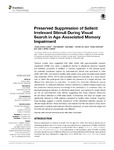Preserved suppression of salient irrelevant stimuli during visual search in age-associated memory impairment

Use este enlace para citar
http://hdl.handle.net/2183/16160
Excepto si se señala otra cosa, la licencia del ítem se describe como Creative Commons Attribution 4.0 International License (CC-BY 4.0)
Colecciones
- Investigación (FCS) [1293]
Metadatos
Mostrar el registro completo del ítemTítulo
Preserved suppression of salient irrelevant stimuli during visual search in age-associated memory impairmentAutor(es)
Fecha
2016-01-12Cita bibliográfica
Lorenzo-López L, Maseda A, Buján A, Labra C, Amenedo E, Millán-Calenti JC. Preserved suppression of salient irrelevant stimuli during visual search in age-associated memory impairment. Front Psychol. 2016;6:2033
Resumen
[Abstract] Previous studies have suggested that older adults with age-associated memory impairment (AAMI) may show a significant decline in attentional resource capacity and inhibitory processes in addition to memory impairment. In the present paper, the potential attentional capture by task-irrelevant stimuli was examined in older adults with AAMI compared to healthy older adults using scalp-recorded event-related brain potentials (ERPs). ERPs were recorded during the execution of a visual search task, in which the participants had to detect the presence of a target stimulus that differed from distractors by orientation. To explore the automatic attentional capture phenomenon, an irrelevant distractor stimulus defined by a different feature (color) was also presented without previous knowledge of the participants. A consistent N2pc, an electrophysiological indicator of attentional deployment, was present for target stimuli but not for task-irrelevant color stimuli, suggesting that these irrelevant distractors did not attract attention in AAMI older adults. Furthermore, the N2pc for targets was significantly delayed in AAMI patients compared to healthy older controls. Together, these findings suggest a specific impairment of the attentional selection process of relevant target stimuli in these individuals and indicate that the mechanism of top-down suppression of entirely task-irrelevant stimuli is preserved, at least when the target and the irrelevant stimuli are perceptually very different.
Palabras clave
AAMI
Automatic attentional capture
ERPs
N2pc
Visual search
Automatic attentional capture
ERPs
N2pc
Visual search
Versión del editor
Derechos
Creative Commons Attribution 4.0 International License (CC-BY 4.0)






